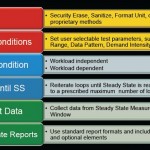SNIA’s Solid State Storage Initiative (SSSI) recently rolled out its new Workload I/O Capture Program, or WIOCP, a simple tool that captures software applications’ I/O activity by gathering statistics on workloads at the user level (IOPS, MB/s, response times queue depths, etc.)
The WIOCP helps users to identify “Hot Spots” where storage performance is creating bottlenecks. SNIA hopes that users will help the association to collect real-use statistics on workloads by uploading their results to the SNIA website.
Using this information SNIA member companies will be able to improve the performance of their solid state storage solutions, including SSDs and flash storage arrays.
How it Works
The WIOCP software is a safe and thoroughly-tested tool which runs unobtrusively in the background to constantly capture a large set of SSD and HDD I/O metrics that are useful to both the computer user and to SNIA.
Users simply enter the drive letters for those drives for which I/O operations metrics are to be collected. The program does not record anything that might be sensitive, including details of your actual workload (for example, files you’ve accessed.) Results are presented in clear and accessible report formats.
How can WIOCP Help You?
Users can collect (and optionally display in real time) information reflecting their current environment and operations with the security of a tool delivered with digital authentication for their protection.
The collected I/O metrics will provide information useful to evaluate an SSD system environment.
Statistics from a wide range of applications will be collected, and can be used with the SSS Performance Test Specification to help users determine which SSD should perform best for them.
How can Your Participation Help SNIA and the SSSI?
The WIOCP provides unique, raw information that can be analyzed by SNIA’s Technical Work Groups (TWGs) including the IOTTA TWG to gain insights into workload characteristics, key performance metrics, and SSD design tradeoffs.
The collected data from all participants will be aggregated and publicly available for download and analysis. No personally identifiable information is collected – participants will benefit from this information pool without comprising their privacy or confidentiality.
Downloading the WIOCP
Help SNIA get started on this project by clicking HERE and using the “Download Key Code”: SSSI52kd9A8Z.
The WIOCP tool will be delivered to your system with a unique digital signature. The tool only takes a few minutes to download and initialize, after which users can return to the task at hand!
If you have any questions or comments, please contact: SSSI_TechDev-Chair@SNIA.org
